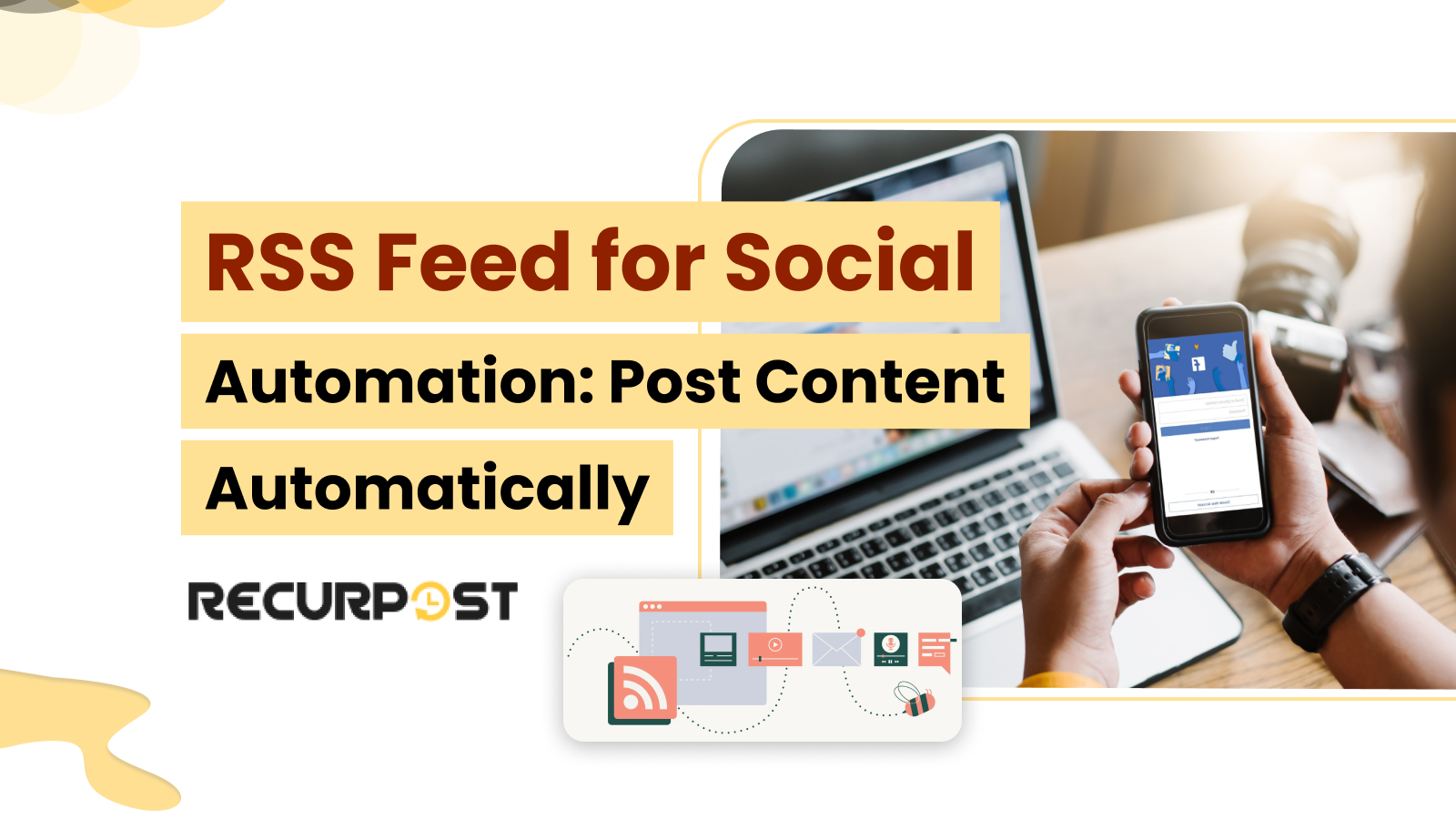Managing social media feels like trying to juggle flaming torches while riding a unicycle. You’re constantly scrambling to share new content, keep up with multiple social media platforms, and somehow maintain a posting schedule that keeps your feeds active across accounts. Sound familiar?
The solution is an RSS feed for social media automation. Web syndication using RSS feeds is sometimes seen as old-school since Google Reader ended in 2013.
Here’s what many people miss: RSS feeds are making a comeback for social media automation. Smart creators, entrepreneurs, and marketers use RSS feeds to automate posts, keep their posting queue steady across media accounts, and streamline their social posting workflow. This makes real-time updates and cross-platform posting simple, so people sleep better at night.
Here, you’ll get a full look at how to use RSS feeds for social media automation. You’ll see the benefits, find out how to automate posting with an RSS feed, and walk through a case study showing step-by-step setup with automated workflows and real-time publishing.
Transform your social media strategy from chaotic to systematic with these web feed steps.
Understanding RSS Feeds For Social Media Strategy
What Exactly Is an RSS Feed?
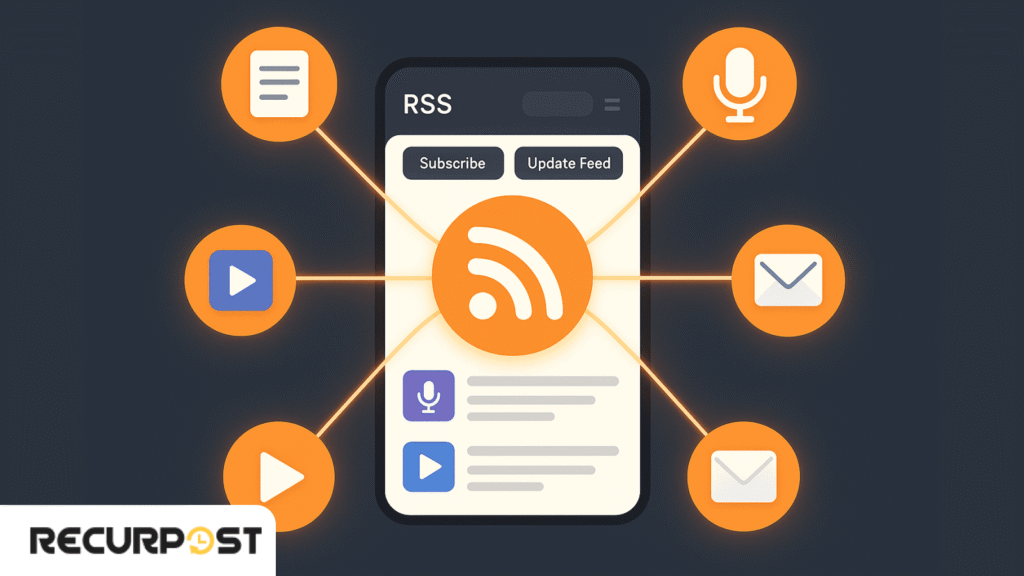
RSS, known as Really Simple Syndication, is a web feed system that lets websites automatically deliver the newest posts, headlines, summaries, or even full articles to other platforms and social media feeds. RSS feeds let subscribers get real-time updates when new content is published, without visiting each website.
An RSS feed works as a content delivery service. When a website, blog, or news source posts new content, it instantly creates a summary that can be picked up by feed readers, aggregators, and even social media automation tools.
The RSS feed notifies subscribers or users right away every time new content or articles go live. This happens automatically, so your audience never misses a post.
Most websites generate RSS feeds automatically. If you’ve got a WordPress blog, for instance, your RSS feed is probably sitting at yoursite.com/feed right now, quietly updating itself every time you publish a post. News sites like BBC, CNN, and TechCrunch have RSS feeds for different categories. Even podcasts use these feeds; that’s actually how platforms like Spotify and Apple Podcasts know when you’ve released a new episode.
What is an RSS Aggregator and Feed Reader?
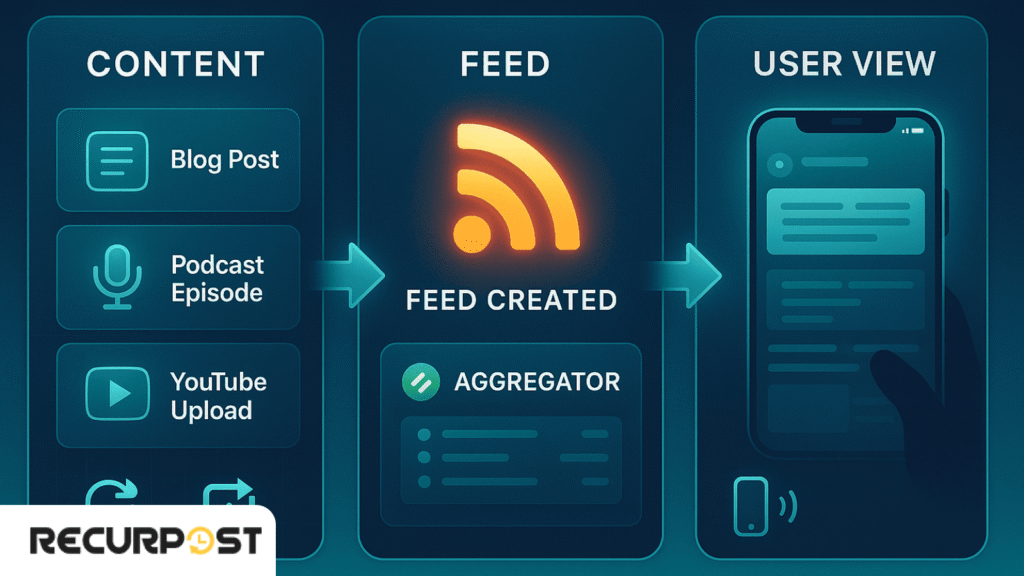
An RSS aggregator, also called a feed reader or news aggregator, is an app or web service that collects content from many websites using RSS feeds. It displays updates, new posts, or articles from all your favorite sources in one place. Users can keep up with fresh content, blog posts, and news from different websites and social media feeds without visiting each site one by one. Popular RSS feed readers and aggregators make it simple to track multiple blogs, podcasts, or industry news on a single dashboard.
Understanding RSS Feeds for Social Media with a Practical Example
Here’s how RSS feeds work in practice for both website and social media management, using a tech influencer as an example of automated content distribution and cross-platform posting:
Syndication Feed Usage Example: Tech Influencer “TechGuru Alex”
Alex is a tech influencer with 500K followers who runs:
- Personal website: techgurualex.com (with a blog and its own RSS feed)
- YouTube channel (using a YouTube RSS feed for updates)
- Instagram (shares posts and stories)
- Twitter (posts real-time updates)
- TikTok (creates video content)
- Email newsletter (sends updates using RSS feed automation)
How Alex Uses RSS Feeds for Social Media
Step 1: Alex Creates Content
Alex writes a new blog post for his website using his WordPress RSS feed: “iPhone 15 vs Samsung Galaxy S24: Which Should You Buy?”
Step 2: RSS Feed Automatically Activates
As soon as Alex clicks “Publish”, his site’s RSS feed (techgurualex.com/feed) instantly generates a standardized summary in XML format for the new content:
- Title: “iPhone 15 vs Samsung Galaxy S24: Which Should You Buy?”
- Description: “After testing both phones for 2 weeks, here’s my honest comparison…”
- Publication date: Today, 2:00 PM
- Author: Alex
- Categories: Smartphones, Reviews
- Feed URL links directly to the full article
This RSS feed can be picked up by feed readers, aggregators, and content automation tools.
Step 3: Automatic Distribution Happens
Social Media Automation:
- Alex uses RecurPost, which monitors his RSS feed 24/7. RecurPost automatically creates and schedules posts across all its social media platforms:
- Twitter: RSS to Twitter updates the feed with “New blog post is live! iPhone 15 vs Galaxy S24 comparison Link in bio”
- Instagram: Auto-post with the blog’s featured image, leveraging RSS Instagram for business integration
- LinkedIn: Shares a professional post with industry insights using the RSS feed
- Facebook: Posting scheduler creates an engaging post with a question to spark comments
Content Aggregation:
- Multiple websites for tech news, like TechCrunch or The Verge, might have RSS readers monitoring popular tech bloggers
- If Alex’s content adds value, RSS feed readers may feature his posts in “Around the Web” sections on blogs or news platforms.
- Google News and other news feed automation services pick up his article, showing it to users looking for phone comparison content.
Email Marketing:
- Alex’s email service (like Mailchimp) monitors his RSS feed
- Subscribers automatically receive a weekly RSS digest: “This week Alex reviewed the iPhone 15 vs Galaxy S24, shared 5 productivity apps, and explained why AI phones are the future.” RSS feed automation powers each email newsletter.
Other Platforms:
- Reddit tech communities and similar platforms can use automated content distribution to share Alex’s posts.
- His new articles appear on news aggregators and RSS readers like Feedly.
- Podcast platforms get notified if he publishes audio content
Real-World Benefits of Syndication Feed for Alex:
- Time Saving: Instead of manually posting announcements on multiple platforms, Alex creates one blog post, and RecurPost’s RSS feed integration uses automation to distribute everywhere, Twitter, Facebook, LinkedIn, Instagram, and more instantly.
- Consistency: Alex’s audience receives real-time updates across every channel, with no platform missed.
- Smart Recycling: RecurPost uses RSS feed automation to schedule recycled content for future posting, boosting reach with automated scheduling.
- Reach Expansion: Tech websites, blogs, and news aggregators pick up his RSS feed, introducing his content to a wider audience through cross-platform posting.
- Professional Credibility: Major tech publications and industry sites monitor RSS feeds, making Alex’s content easy to find and feature in their curated news and blog sections.
How a Syndication Feed Powers Instant Content Distribution:
When Alex publishes that iPhone comparison:
- RecurPost detects the new RSS feed update within minutes, thanks to real-time content synchronization.
- It automatically generates platform-specific posts, adapting formatting for each social media account.
- His favorite website with 50k subscribers gets instant notification through their RSS feed aggregator.
- Tech news sites track new content in their feed readers and RSS aggregators.
- Alex’s email list receives a summary in the weekly RSS digest.
- Google indexes the blog faster as RSS feeds signal fresh content to search engines.
- Other influencers and blogs monitoring tech RSS feeds may feature or share his content.
RecurPost’s RSS Advantage:
Unlike manual posting, RecurPost’s RSS integration means:
- Alex can schedule his blog posts to publish at 2 PM, and social media posts automatically go live at peak engagement times (7 PM for Instagram, 9 AM for LinkedIn, etc.).
- The platform learns which RSS-generated posts perform best and can automatically boost similar content.
- Alex can set up different RSS rules for different social platforms, a professional tone for LinkedIn, casual one for Twitter.
Why this Feed Matters:
Alex doesn’t need to keep track of every posting schedule or copy-paste content across platforms. RSS feeds with RecurPost create an automated workflow that acts as a digital marketing assistant, working all day to deliver content to every social media platform with platform customization and real-time publishing.
This is why top influencers rely on RSS feeds connected to content automation tools like RecurPost. It gives them automated content distribution, cross-platform presence, and consistent posting without extra effort, scaling their reach without adding more work.
Why RSS Still Matters in 2025
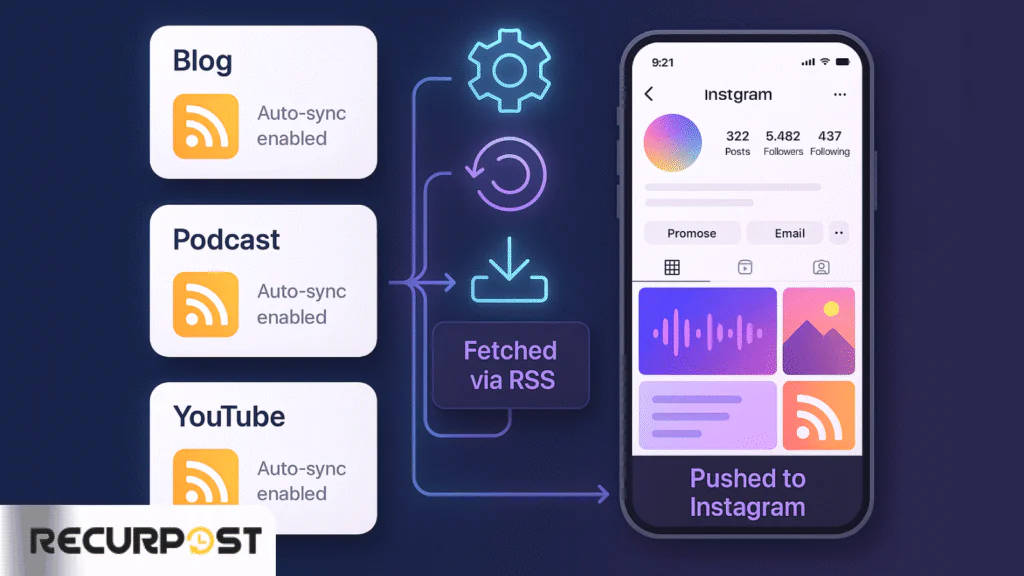
Many assume RSS feeds disappeared when Google Reader ended, but that isn’t the full story. While casual RSS reading apps lost popularity, these feeds are now at the center of content automation and distribution for websites, blogs, and social media feeds.
Surveys show that over 60% of content marketers rely on RSS feed automation in their workflow. The need for efficient content distribution never fades—even as social media platforms and posting schedules keep changing.
Here’s what’s driving renewed growth in RSS usage:
Content creators produce more posts and updates across multiple platforms, blogs, and social accounts. While social media algorithms change frequently, RSS feeds provide consistent, real-time distribution. Your content appears in every connected platform, regardless of algorithm changes.
On top of that, automation tools now make RSS feed integration fast and easy. Anyone can set up RSS for social media accounts, blogs, or websites in minutes—no coding or developer needed. Just a few clicks and your feeds are ready for posting and syndication.
The Real Benefits of Using RSS Feeds for Social Media
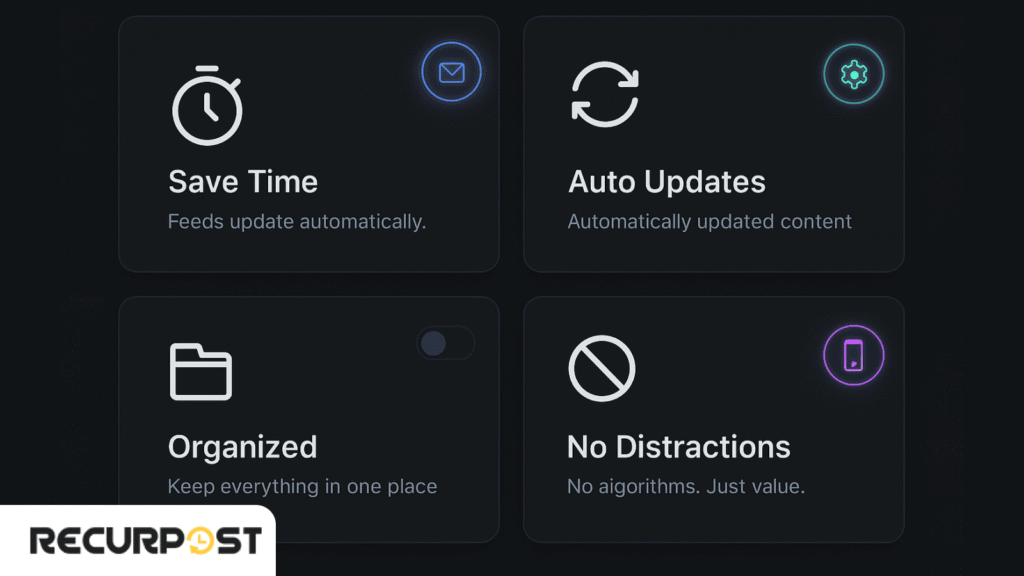
Time Savings with Syndication Feeds
Comparing traditional social media posting with RSS feed automation shows a clear difference in time savings and workflow efficiency.
Traditional approach:
Publishing a blog post means you have to manually create separate posts for Twitter, LinkedIn, Facebook, and Instagram. Each one needs its own posting schedule set for the best times, taking 20 to 30 minutes for every piece of content.
RSS approach:
With RSS feed automation, once you publish a blog post, customized versions appear on every connected social media account, including Twitter, Facebook, Instagram, and LinkedIn. These feeds send updates to your posting scheduler and social media automation tools, so posts go live within minutes. After initial web feed setup, there’s no extra work.
One content creator found RSS automation saved 8 hours a week, a full workday shifted from manual distribution to new content creation and planning.
Consistency in Feed Without the Stress
Social media growth drops if posting is not steady. Algorithms reward accounts that keep a regular posting schedule, but staying consistent by hand is draining, and missed weeks mean lost engagement.
RSS automation delivers a steady stream of content to all your feeds, no matter how busy your schedule gets. Blog posts, news articles, and podcast episodes are sent to your audience through RSS feed automation, maintaining brand consistency and audience engagement even if you are focused elsewhere.
Real-Time Content Distribution
Time-sensitive updates and trending topics need fast sharing. RSS feed automation updates your web feed in real time, sending new blog posts, articles, or podcasts to every social media account within minutes.
Tools like RecurPost or Buffer use these feeds and posting schedulers to publish across platforms like Twitter, Facebook, Instagram, and LinkedIn, saving you time and keeping your audience informed with the latest content.
Content Curation Made Simple
RSS feeds let you curate posts from your favorite websites, blogs, and industry news. Using RSS aggregators and feed readers, you can add content from multiple sources to your social media feeds. Set up automation rules and keyword filters so only the most relevant updates reach your audience. Personalize your social media posts with your own commentary, images, or hashtags for more engagement.
Live News Integration for Real-Time Social Media Updates
Breaking news and fast-moving trends need instant updates. Manual posting can miss the action, but RSS feeds are built for live news integration.
RSS feeds capture new articles and updates from major publishers like Reuters, AP News, or industry news sources. Automation tools then push these live news updates to your social media accounts within minutes of publication.
Here’s how live news RSS integration works: Connect your automation system to news RSS feeds from sources like BBC News, TechCrunch, or other industry publications. Use feed configuration and keyword filters to focus on topics that matter, like “artificial intelligence”, “cryptocurrency”, or “marketing trends”, so only the most relevant breaking news appears in your social media feed.
Your automation workflow tracks these feeds nonstop, picks out matching articles, and posts them along with your custom commentary or insights. This keeps your channels current and positions you as a top source for fresh, trending news.

Always add your insight or question when sharing breaking news. Instead of just posting “New AI regulation announced,” try “New AI regulation just dropped, this could change how we approach content creation. What’s your take?”
Step-by-Step: Building Your RSS Social Media Strategy

Step 1: Identify and Prepare Your RSS Sources
First, decide which content you want to share or automate. Your own blog is usually the main RSS source. Most content management systems, like WordPress or Squarespace, create an RSS feed for you by default. To find it, just add “/feed” or “/rss” to your website’s URL.
But your blog isn’t the only option. Consider using:
- Podcast RSS feeds, if you have a podcast
- News RSS feeds from trusted industry publications
- YouTube channel RSS feeds for sharing new videos
- Medium or LinkedIn newsletter RSS feeds for more content
Add each feed URL to your preferred automation platform, such as RecurPost or Buffer. You can use feed configuration and content filtering rules to control what gets shared on your social media accounts.

Test your RSS news feeds before connecting them to automation tools. Load them in a browser or RSS reader to make sure they’re formatting correctly and including all the information you want to share.
Step 2: Select the Right Automation Tool to Connect your Feed
Options range from simple to sophisticated automation tools that connect with your web feed:
For Beginners: IFTTT,
IFTTT (If This Then That) is simple and free. It connects your RSS feed to social media accounts in minutes. Set up basic RSS-to-Twitter, RSS-to-Facebook, or RSS-to-LinkedIn sharing quickly. Great for automatic blog posts or new updates with minimal setup.
For Power Users: Zapier
Zapier creates more advanced feed automation workflows. You can use filters, custom formatting, and connect your RSS feed to multiple platforms at once, like Facebook, Twitter, Instagram, or even Google Sheets. Add extra steps, manage posting frequency, and tailor posts for each network.
For Social Media Focused: RecurPost
RecurPost monitors RSS feeds and uses a posting scheduler to create and publish platform-specific content across all social networks. With features like cross-platform posting, brand consistency, content queue management, and feed-based marketing, RecurPost is built for serious social media automation.
For News and Content Sites: Dlvr.
If you’re running a news site or content-heavy brand, Dlvr.it specializes in RSS-to-social automation with features like automatic hashtag generation and link shortening.
Learn About: Best RSS Feed Reader For Streamlining
Experience: Popular RSS reader for iPhone
Step 3: Set Up Your Feed Automation
You’re not just connecting a web feed to your social platforms; you’re building a system that keeps your brand consistent everywhere.
Timing and Frequency
Decide how often your automation tool should check your web feed for new updates. Many scheduling tools default to checking every 15 minutes, but you can set longer intervals to avoid overposting. Align the timing with your publishing schedule and platform preferences.
Content Filtering
Not all updates need to appear on every account. Use category, tag, or keyword filters in your automation platform to send the right content to the right place. For example, technical blog posts might work best on LinkedIn, while visual updates perform better on Instagram.
Platform Customization
Each network has its own rules, so their RSS feed are different as well. Twitter has character limits, LinkedIn prefers a professional tone, and Facebook does better with questions or polls. Your automation workflow should adapt your content format, style, and scheduling for each network.
Step 4: Monitor and Adjust Performance
RSS automation and feeds are not set-it-and-forget-it systems. Use your content monitoring system and performance tracking features to see how automated posts compare to manual updates.
Check engagement, clicks, and audience feedback. If your automated updates are not performing as well as manual posts, adjust your formatting, timing, or filtering rules. Continue refining your automation workflow for better results and audience engagement.
RSS Automation Tools That Work: A Realistic Comparison
Here’s a breakdown of RSS automation tools and their capabilities:
| Tool | Free Plan | Best For | Key Features | Reality Check |
| RecurPost | Limited | Small businesses wanting RSS + scheduling | RSS automation, content library, multi-platform | Great for beginners, but advanced features require paid plans |
| Zapier | 5 workflows | Custom automation needs | Multi-step workflows, extensive integrations | Powerful but complex, expect a learning curve |
| Dlvr.it | 3 feeds | News sites and content aggregators | Auto-hashtags, link shortening, and advanced filtering | Reliable, but the interface feels dated |
| IFTTT | 3 applets | Simple, single-step automations | Dead simple setup, basic functionality | Limited customization, frequent service hiccups |

Start with IFTTT to test the concept, then graduate to Zapier or RecurPost when you’re ready for more control. Don’t feel pressured to go premium immediately; free plans are often enough to validate whether RSS automation works for your specific situation.
White Label RSS Marketing Solutions for Agencies
If you run a marketing agency or manage social media for clients, white-label automation tools let you deliver automated content syndication under your own brand. These platforms remove their logos from dashboards, reports, and client portals, making everything look like your in-house technology.
White label RSS marketing solutions for agencies typically include client management dashboards, custom domain options, and API access for deeper integration with other tools. Some providers, such as Dlvr.it and other agency-focused platforms, offer packages that let you control multiple client accounts and content sources from a single dashboard while maintaining custom branding for each client.
The big benefit: you can deliver advanced automation and content distribution without building the system yourself. Clients see your logo everywhere, while you handle account management and content scheduling behind the scenes using RSS automation tools. Most pricing plans scale with the number of accounts or content sources, so agencies of any size can use these RSS automation tools to grow their service offering.
How to Use RecurPost for RSS Feed Updates And Automation
RecurPost offers a beginner-friendly setup process:
Account Setup and Social Media Integration
After creating your RecurPost account, you’ll need to connect your social media platforms. The process is straightforward; just authorize RecurPost to post on your behalf for each platform you want to use.

Don’t connect every platform immediately. Start with your two most important channels, get comfortable with the system, then expand.
Adding and Configuring Your RSS Feed
Go to the automation section of your dashboard and add your feed URL. RecurPost automatically imports your latest content and shows a preview for each social media platform.
Set how often your web feed updates every 30 minutes, hourly, or daily. You can pick which categories to share and add keyword filters, so only relevant posts reach your audience.
Customizing Posts: Making Automation Feel Human
RecurPost’s platform lets you:
- Add custom text or emojis to each post
- Include hashtags automatically
- Adjust formatting for each network
- Add calls to action for more engagement
This makes every automated update feel thoughtful, not mechanical or by RSS automation.
Scheduling and Performance Tracking
RecurPost comes with analytics to show which posts get the most engagement. Use this info to improve your scheduling, post formatting, and what content you share over time.
For detailed RecurPost setup instructions, their official RSS integration guide walks through every step with screenshots.
Common Mistakes to Avoid (Learn From Others’ Pain)
Relying on Full RSS Automation Without Personalization
A common mistake is thinking that automation with RSS is a set-and-forget system. Your automated posts still need your brand’s voice and should add value for your followers.
Avoid sharing only raw web feed titles. Add your own context, questions, or comments so your updates reflect your brand, even as automation handles distribution.
Posting Duplicate Messages Across Platforms
Every social platform has its own style and best practices for web feeds. A LinkedIn post shouldn’t match a Twitter update, even if you’re sharing the same link.
Use your automation platform’s customization options along with RSS to adjust content for each account. Twitter might work better with questions or quick tips, while LinkedIn can use a professional summary with industry news
Ignoring Feed Formatting and Previews
Not all web feeds are the same. Some send full articles, others just short summaries. Before scheduling using RSS automation, preview how your content will appear on social media to check for any formatting issues.

Preview your automated posts, check how images display, and make sure links work properly.
Skipping Analytics and Optimization
Don’t ignore performance, as automated posts should perform at least as well as your manual ones; if they don’t, something needs adjustment.
Monitor engagement rates, click-through rates, and audience feedback. If automated posts consistently underperform, dig into why and adjust your strategy.
Your Next Steps: Making RSS Automation Work for You
RSS feeds and automation systems for social media aren’t magic, but they work well when set up right. You’ll still need to create quality content, engage with your audience, and monitor results, but you’ll save time and reduce stress.
Start simple and build your RSS automation workflow as you go. Don’t automate every account with RSS right away. Pick one main content source, connect it to your top social networks, and watch how it improves your posting process.
Most people who try automation with RSS wish they had done it sooner. Saving hours each week is just one benefit; the steady presence and peace of mind are what make automation using RSS essential.
This approach solves the main challenge of social media marketing: staying active and valuable across multiple platforms without burning out. Automation tools take care of content delivery and scheduling, so you can focus on making content your followers enjoy.
Test things out with free tools like IFTTT (If This Then That)for your first RSS automation experience, then move to more advanced platforms as your needs grow.
Get started today: Try RSS automation with RecurPost and start seeing results within the week, or download our free RSS Automation Checklist to begin with a clear, step-by-step plan.
The choice is yours: keep manually posting content across platforms, or let automation handle the heavy lifting while you focus on creating amazing content.
FAQs About RSS Social Media Automation
1. What is an RSS feed, and how does it help with social media automation?
A web feed (commonly called RSS or Really Simple Syndication) is a format that pulls fresh updates from blogs, podcasts, or news sites. When you connect it to social media scheduling tools such as RecurPost or Buffer, it can automatically share your latest content on platforms like Instagram, Twitter, Facebook, or LinkedIn without manual posting.
2. Can I use RSS to schedule social media posts from my blog or YouTube channel?
Yes! You can plug your blog or YouTube RSS feed into social media tools to automatically schedule and share new posts. This saves time, keeps your feed active, and ensures your audience always gets fresh content without manual uploads.
3. Is using RSS feeds better than relying on social media algorithms?
With a feed-based workflow, you control what gets posted and when, giving you reliable distribution and steady organic reach. You’re not at the mercy of unpredictable algorithm changes—your content appears for your audience on your terms.
4. How can RSS feeds help with content curation on social media?
You can pull in updates from many trusted sources into one place, then pick or automate sharing of top articles, news, and podcasts. This helps you build authority, keep your audience engaged, and post a variety of high-quality content—all with less effort.
5. What are the best tools to use RSS feeds for social media scheduling?
Top tools include Recurpost, Buffer, Hootsuite, Feedly, Zapier, and dlvr.it. These platforms let you connect RSS feeds, set posting schedules, customize captions, and track performance, all from one dashboard.
6. What does RSS stand for?
RSS stands for “Really Simple Syndication” or “Rich Site Summary”.

Fenil Patel makes complex topics simple and useful for readers who want clarity, value, and actionable takeaways. As an SEO content writer with 4+ years of experience, he creates blogs and website content that answer real questions, solve problems, and guide readers toward informed decisions. Whether it’s healthcare, fashion, or SaaS, Fenil’s writing is designed to give you practical insights while ensuring the information you read is trustworthy, engaging, and easy to apply.

